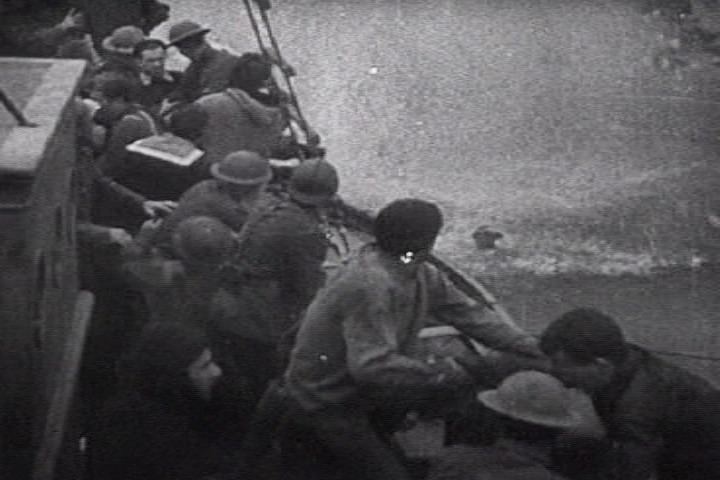 | ||
The little ships of Dunkirk were 700 private boats that sailed from Ramsgate in England to Dunkirk in France between 26 May and 4 June 1940 as part of Operation Dynamo, helping to rescue more than 338,000 British and French soldiers who were trapped on the beaches at Dunkirk during the Second World War.
Contents
Overview
The situation of the troops, who had been cut off from their retreat into France by a pincer movement from the German army, was regarded by the British prime minister Winston Churchill as the greatest military defeat for centuries; it appeared likely to cost Britain the war, leaving the country vulnerable to invasion by Germany. Because of the shallow waters, British destroyers were unable to approach the beaches, and soldiers were having to wade out to the warships, many of them waiting hours shoulder deep in water.
On 27 May, the small-craft section of the British Ministry of Shipping telephoned boat builders around the coast, asking them to collect all boats with "shallow draft" that could navigate the shallow waters. Attention was directed to the pleasure boats, private yachts and launches moored on the River Thames and along the south and east coasts. Some of them were taken with the owners' permission – and with the owners insisting they would sail them – while others were requisitioned by the government with no time for the owners to be contacted. The boats were checked to make sure they were seaworthy, fueled, and taken to Ramsgate to set sail for Dunkirk. They were manned by Naval Officers, Ratings and experienced volunteers. Very few owners manned their own vessels, apart from fishermen and one or two others.
When they reached France, some of the boats acted as shuttles between the beaches and the destroyers, ferrying soldiers to the warships. Others carried hundreds of soldiers each back to Ramsgate, protected by the Royal Air Force from the attacks of the Luftwaffe.
Notable boats
RNLI lifeboats at Dunkirk
See also individual stations for more information in many cases.
Isle of Man Steam Packet Company
At the outbreak of war, 10 of the 16 vessels in the fleet of the Isle of Man Steam Packet Company were requisitioned. Four were lost.
Eight of the company's ships took part in the Dunkirk evacuation. Mona’s Isle was the first to leave Dover, and the first vessel to complete a round trip. By the end of operations, the fleet had rescued a total of 24,699, 1 in 14 of those evacuated from Dunkirk.
Whilst the evacuation is widely regarded as the Isle of Man Steam Packet Company's "finest hour", it also saw its blackest day. Three of its ships were lost in one day, 29 May 1940.
Dutch coasters
Thirty-nine Dutch coasters had escaped the occupation of the Netherlands by the Germans on 10 May 1940 and were asked by the Dutch shipping bureau in London or by the Royal Navy to assist. The Dutch coasters, able to approach the beaches very closely due to their flat bottoms, rescued 22,698 men in total.
The MV Rian, a 35 metres (115 ft) ship measuring 300 ton dwt and built in 1934 in the province of Groningen, saved 2,542 men between 28 and 31 May 1940 under Captain D. Buining, the most men saved amongst the Dutch coasters. The vessel had already saved the crew of the British coaster SS Highwave on 30 January 1940. Other Dutch coasters that saved more than 1,000 men each were:
Of these ships, seven were lost at Dunkirk or during the evacuation nearer the British coast.
Belgian ships
The Belgian Army, commanded by King Leopold III, had surrendered to the Germans on 28 May. However, numerous ships from the fishing fleet and small Corps de Marine were involved in Operation Dynamo. In total, 65 Belgian ships participated, including 54 fishing boats, 4 Corps de Marine units, 4 tugs and 2 patrol vessels. The Belgian fishing fleet itself transported 4,300 British and French soldiers to the English coast.
Among the notable Belgian ships to participate in the evacuation were:
Results
In nine days, 192,226 British and 139,000 French soldiers – 331,226 in all – were rescued by the 700 little ships and around 220 warships. The rescue operation turned a military disaster into a story of heroism which served to raise the morale of the British.
It was in describing the success of the operation to the House of Commons on 4 June 1940 that Churchill made one of his most famous speeches:
We shall go on to the end, we shall fight in France, we shall fight on the seas and oceans, we shall fight with growing confidence and growing strength in the air, we shall defend our Island, whatever the cost may be, we shall fight on the beaches, we shall fight on the landing grounds, we shall fight in the fields and in the streets, we shall fight in the hills; we shall never surrender ...
The phrase "Dunkirk spirit" is still used to describe courage and solidarity in adversity.
The Association of Dunkirk Little Ships is an association for owners of Dunkirk Little Ships, founded in 1965. The Association organizes a memorial crossing of Little Ships to Dunkirk every five years, escorted by the Royal Navy. Its flag is the St George's Cross defaced with the arms of Dunkirk flown from the jack staff, known as the Dunkirk jack.
The Dunkirk Little Ships Restoration Trust is a registered charity established in 1993 to preserve and restore Dunkirk Little Ships. Its collection includes the steam tug ST Challenge, a vessel in the National Historic Fleet.
